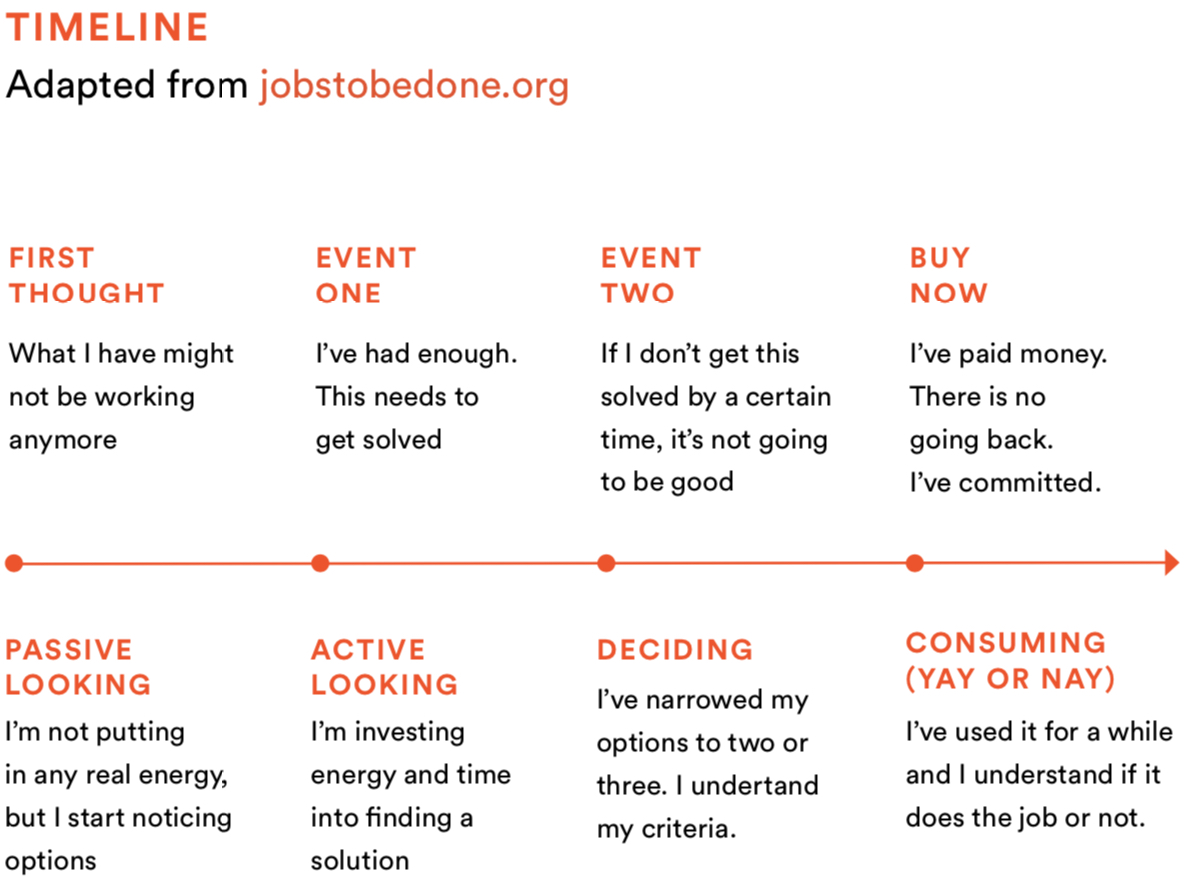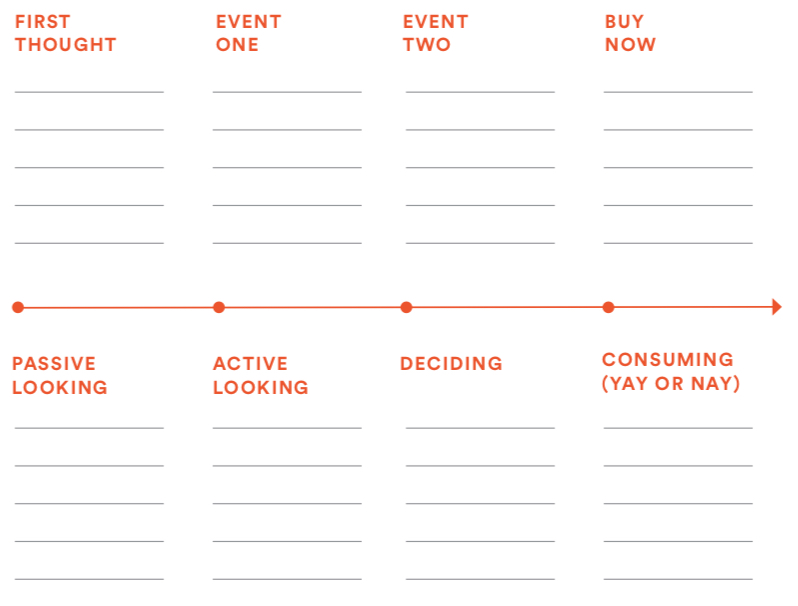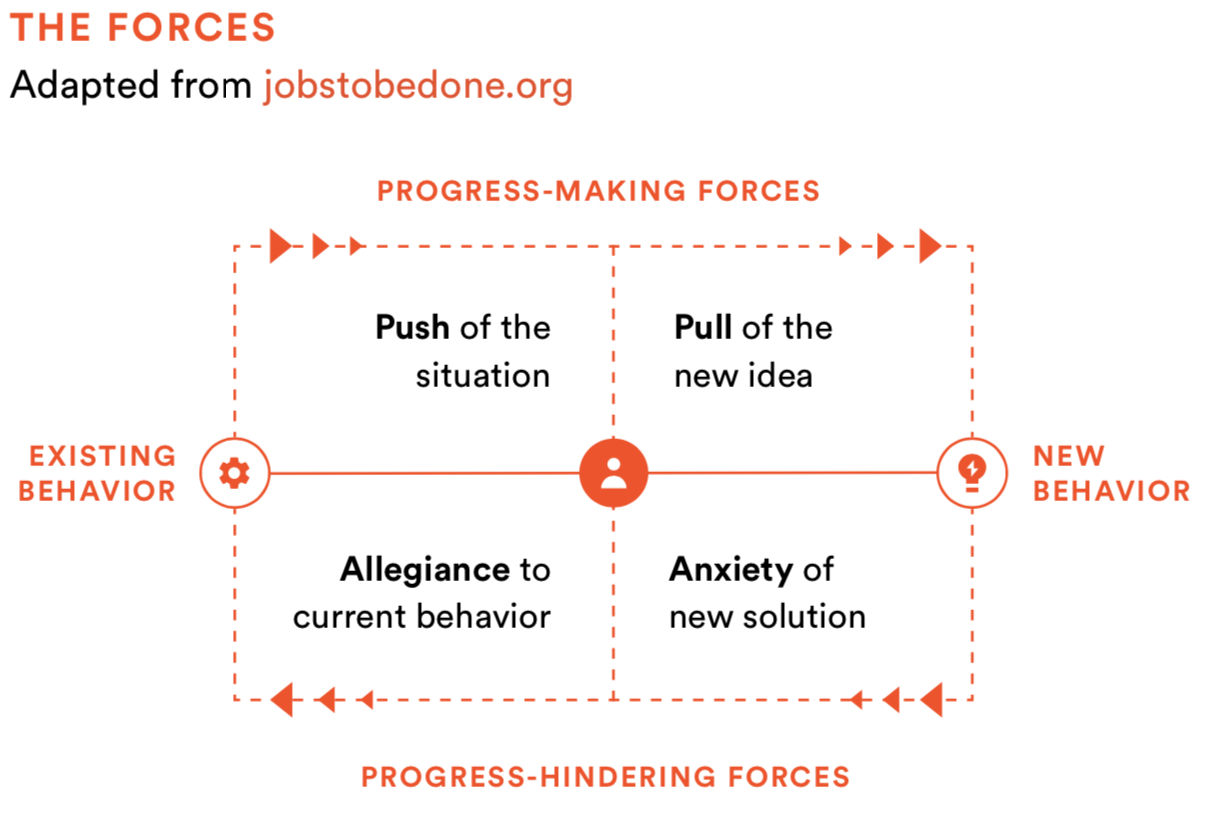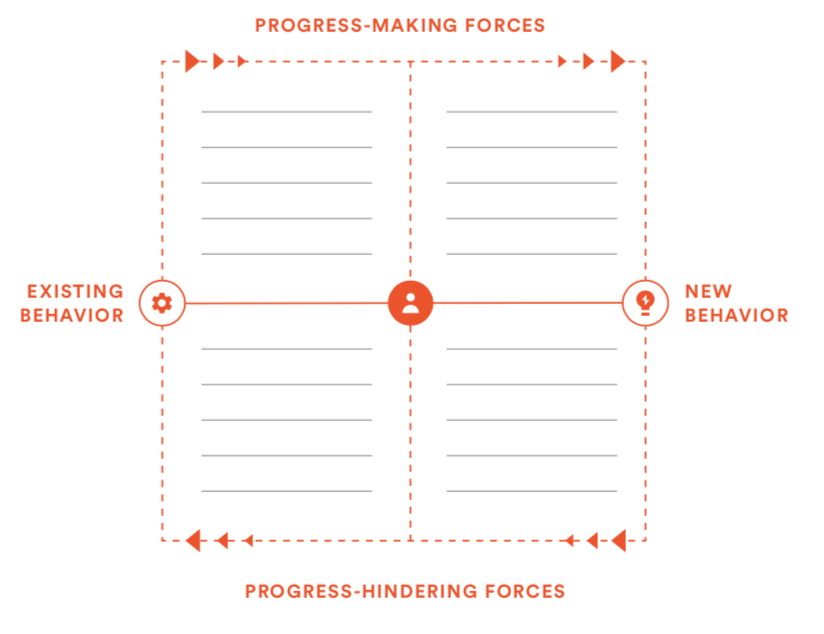How To Know What Clients Want, Part 3: 15 Strategic Questions That Increased Our Coaching Revenue By 50% In A Single Year
++
Health and fitness has been historically bad at figuring out why clients really hire us. This leads to hit-or-miss marketing, confused prospects, unsatisfied customers. This 3-part series offers a better approach to knowing what clients want and delivering it every time. In part 3, the exact questions to ask to do Jobs To Be Done right.
++
I Bought That Drill To Feel Calm and Safe
While there are many ways to learn more about your prospects and clients—and I use a host of them, including informal surveys on Facebook, more extensive surveys using Survey Monkey, in-person focus groups, thinking aloud sessions, and more—my favorite, and most insightful, tool is the Jobs To Be Done (JTBD) framework.
As mentioned in Part 1 of the series, JTBD is an interview and analysis technique that seeks to uncover the “jobs” that people “hire” products and services to do.
While it sometimes feels odd to think that something like a drill can be “hired” to do a job and “fired” if it doesn’t do that job, this is an accurate representation of why people buy things.
After all, as Harvard marketing professor Theodore Levitt famously said, “People don’t want to buy a 1/4-inch drill bit. They want a ¼-inch hole.” So they “hire” the drill bit to do the “job” of boring out the hole.
Yet, as Seth Godin points out: “That doesn’t go nearly far enough. No one wants a hole. What people want is the shelf that will go on the wall once they drill the hole.
Actually, what they want is how they’ll feel once they see how uncluttered everything is, when they put their stuff on the shelf that went on the wall now that there’s a quarter-inch hole.
But wait… they also want the satisfaction of knowing they did it themselves. Or perhaps the increase in status they’ll get when their spouse admires the the work. Or the peace of mind that comes from knowing that the bedroom isn’t a mess, and that it feels safe and clean.”
So, as Seth points out, people hire drills not to drill holes but to earn pride, respect, calm, and safety.
To this end, a “job to be done” is not a product, service, or specific solution. It’s the “higher purpose” for which customer buys products, services and solutions.
So Why Are Your Clients and Customers Hiring You?
Consider why people “hire” personal trainers. Is it because they’re desperate to put heavy barbells across their backs and squat up and down more often? Probably not.
So why do most trainers fetishize program design and exercise selection?
Why doesn’t some portion of their coaching address the deeper needs of clients, usually related to feeling better in their bodies, to reducing both physical and psychic pain?
Because they don’t exactly understand the job to be done.
Likewise, consider why people “hire” physicians. Is it because they want to be on meds or go under the knife? Probably not.
So why, then, do many physicians rush through appointments, make it rain prescriptions, and shuttle people to pre-op?
Why doesn’t some portion of their doctoring address the deeper needs of patients, usually related to feeling less fragile, to more gracefully accepting their mortality?
Because they, too, don’t exactly understand the job to be done.
The JTBD framework is so valuable because it helps remind us that people don’t buy services or products; they hire relevant solutions at different times to get a wide array of jobs done.
How To Use Jobs To Be Done In Your Business
The Jobs To Be Done framework was created by Harvard Business School professor Clay Christensen. Bob Moesta, one of Christensen’s colleagues from Harvard, shared it with my business partner and I, and it changed our business.
Within one year, after doing dozens of interviews with prospects and clients, and adapting both our product offerings and our marketing / advertising in response to those interviews, our revenue increased by 50 percent.
Sounds good, right?
Even better, you can do it yourself.
Here’s how to use it in your own business.
Step 1.
Begin with clear questions that you need answered, such as:
- Why do people hire my product or service?
- Why do people fire my product or service?
- How are people struggling with my product or service?
- Where are my opportunities to improve my product or service?
Step 2.
Identify people in each of the relevant buying stages, such as:
- Those who expressed interest but didn’t buy your product/service.
- Those who did buy your product/service.
- Those who bought and are actively using the product/service.
- Those who bought but aren’t actively using the product/service.
- Those who bought but then later returned your product/service.
You could also look for people at various stages such as:
- Within one month of buying your product or service.
(This can help you understand why they “hired” it in the first place.) - Within one month of returning your product or leaving your service.
(This can help you understand why they “fired” it.) - Mid-way through the use of your product or service.
(This can help you understand what they’re struggling with.)
(It can also highlight what they’re hoping you can improve.)
It’s also extremely useful to interview prospects who expressed interest in your product or service but didn’t buy, or who went on to buy something else.
Step 3.
Once you’ve identified your groups, conduct structured interviews.
To understand the point of sale, ask:
- When did you buy the product?
- Where were you?
- What time of day was it? (daytime/ nighttime?)
- Was anyone else with you at the time?
- How did you buy the product?
To find their first thought about purchasing, ask:
- When did you first start looking for something to solve your problem?
- Where were you?
- Were you with someone? What did they say?
- What triggered you to think about this?
To discover what else they considered when weighing their options, ask:
- Tell me about how you looked for a product to solve your problem.
- What kind of solutions did you try? Or not try? Why or why not?
To uncover the emotions associated with the purchase, ask:
- What was the conversation like when you talked about buying the product with your <spouse/friend/parents>?
- Before you bought, did you imagine what life would be like with the product? Where were you when you were thinking this?
- Did you have any anxiety about buying? Did you hear something about the product that made you nervous? What was it? Why did it make you nervous?
Of course, these are sample questions that should be modified based on whether you’re interviewing someone hiring your program, firing your program, or in the midst of experiencing your program.
In the case of hiring or firing, what’s most important initially is that the interview accesses their memory of events surrounding the action. That’s why we start by asking about “when,” even though we already know exactly when they purchased or dropped out.
From there you might ask, “And where were you when you did this? Were you with anyone? Do you remember what the weather was like?”
Again, you’re not necessarily interested in the specific details, but in activating their memory and exploring events adjacent to the action. This helps uncover the emotional forces in their decision-making. These are forces that people usually don’t mention because they seem unrelated or uninteresting. However, they provide the best insights for product refinement and/or improved marketing and advertising.
Step 4.
Create a timeline to understand clients’ decision-making processes.
This will give you a sense for the thoughts and events that brought them to hiring, using, or firing what you’ve created.
Here’s an example of what a timeline might look like:

Once you’ve collected your interviews, you can organize their answers into individual timelines as follows:

Step 5.
Identify the forces that moved customers towards or away from purchasing your product or service.
Forces help you map out the feelings that lead a customer toward hiring or firing your thing vs. the forces that lead them away from hiring or firing your thing.

Here’s a template you can use to map out the individual forces that helped your clients make their decisions:

Step 6.
Organize your interviews to look for common themes.
- What nudged people to make their decision?
- Who did they see as “the competition”?
- Which anxieties did they have to overcome to purchase?
- How did what they thought they were buying match up to what they actually got?
An Example From Precision Nutrition
Precision Nutrition, for example, typically interviews about ten people at each stage of their customer journey. For example, to better understand Precision Nutrition Coaching for Men, we interviewed:
- Men who didn’t buy
Within one month of registration, we interviewed ten men who expressed interest but didn’t buy coaching. - Men who did buy
Within one month of registration, we interviewed ten men who bought coaching. - Men actively using coaching
Mid-way through the program, we interviewed ten men actively using coaching. - Men not actively using coaching
Mid-way through the program, we interviewed ten men not actively using coaching. - Men who dropped out
Within one month of leaving, we interviewed ten men who dropped out coaching.
Listening carefully to their stories, we constructed a timeline for each individual (the events and thoughts that took them from first thought, to buying, to consuming or not) and examined the forces at work throughout (the things that pushed them toward buying and away from buying).
Next, we looked at all the individual timelines and forces next to each other and searched for common themes. We looked for what nudged them to make their decision, for who they thought of as “the competition,” and for which anxieties they had to overcome to purchase.
Also, once they’ve purchased, we looked for what they thought they were buying and compared that to what they felt they were actually getting once they used the product or service.
The Benefits of Jobs To Be Done
Once you’re finally able to see yourself “through customers’ eyes,” you can ask better questions like:
- How can I talk about my business in a way that resonates more with how my customers talk about their needs, challenges, and concerns?
This might make your products and services more attractive or feel like they’re in better alignment with customer needs. Do this right and they’ll think: Wow, this company understands exactly what I’m looking for! - How can I reach out to people in places I’ve never considered before?
This could help open up new markets. For example, if prospects generally sign up for services like yours after a significant “trigger” event—like having a child, getting a scary medical diagnosis, ending a relationship, or moving to a new area—why not market to folks who’ve experienced such an event? - How can I see my customers’ trajectory and anticipate where they’re heading?
This could help you develop new products. For example, if you notice people struggling after a 12-week weight loss program, you might create a maintenance program designed to help graduates preserve most of their weight loss and come to terms with any rebound weight gain.
In the end, knowing what clients really want means you don’t assume you know what they want. It means you don’t copy others because you assume they know what clients want. It means you don’t even ask your clients what they want.
Instead, it means using the inquisitiveness of a detective and the compassion of a counselor to ask the right questions, listen intently, and think deeply. If you do all three you’re more likely to unlock their deepest emotional reasons for taking action.
In these you’ll see your biggest opportunities in coaching, product development, sales, or marketing. And you’ll easily set yourself apart from everyone else in the industry.
Want to learn more?
Then check out Dr John Berardi’s one-of-a-kind book – winner of the 2021 Axiom Business Book of the Year – Change Maker: Turn Your Passion For Health and Fitness into a Powerful Purpose and a Wildly Successful Career.
The health and fitness industry is huge, highly competitive, and often confusing to navigate. Dr. Berardi helps you make sense of the chaos, laying out a clear roadmap to help you achieve both personal and professional success.
